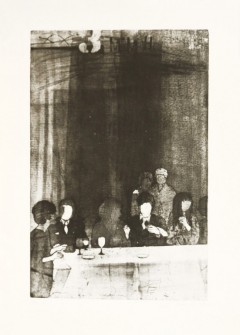Semi Nude
022511 by Moises KISLING [1891-1953]
Semi Nude
colour lithograph on board, dimensions: 71 x 55 cm
signed l. l. on the plate: 'Kisling', signed l.l. with pencil: '58/150'
signed l.r.: `Jean Kisling` in oval, dry seal: `ATELIER KISLING`
Moise Kisling [1891-1953] was born in Cracow, where he studied at the Academy of Fine Arts, in the atelier of Józef Pankiewicz. At the age of 19 he moved to Paris, where he was introduced to paintings of Amadeo Modigliani, Chaim Soutin or Juan Gris. In 1912 he met Picasso and Braque. These last two artists influenced an early period of Kisling's ouevre. The painter was interested in postimpressionism, cubism and expressionism. Eventually he became a member of prestigious artistic environment called "Ecole de Paris".
In 1912 and 1913 Kisling displayed his work at the Autumn Salon, later in 1914 also at the Salon of Independent Artists (Salon des Indépendants). Kisling lived in Montparnasse where he opened his atelier, often visited by the most important artists like Picasso or Derrain. Because of his popularity among parisian artistic world, he was called "The Prince of Montparnasse".
Kisling's style is the mix of polish expressionism, cubism and Cezanne's postimpressionism. He painted a lot of landscapes, still natures, but the portraits are his most important ones. Persons on his pictures usually has big, sad eyes and strongly articulated brows. Another characteristic feature is separation of light colours.
"Seminude", presented in our gallery, is an example of his most famous works. The woman has big, sad eyes and she is looking down. Composition of painting is divided into three main colours: yellow, green and blue. The model resambles the one in another Kisling's painting "Jeune femme blonde au fichu rose" from 1935. Artist notouriously painted the same models, his favourite was famous Kiki de Montparnasse. Kisling was appreciated by polish artistic world and included in "First Exposition of Polish Expressionists" in Cracow in 1917. His glorious period lasted untill 1939, when he was forced to join French army. After he was wounded in the battlefield he was recovering at the Montparnasse, where again he was involved in the artistic life of the city. After recovery he moved to the United States and established another artistic environment among his atelier. He returned to France and died in 1953. His artworks were included in numerous museum collections all over the world, they can be seen in Paris, Geneva or Warsaw.















